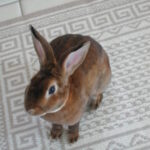Many people see adorable, fluffy rabbits hopping around in store windows around Easter and at the spur of the moment, buy one. Becoming a rabbit owner takes a lot of thought and consideration before one is purchased. A big concern before deciding to purchase a rabbit is the environment it would be coming home to. Do you have young children who may not be able to handle a small rabbit, or who easily get bored? A rabbit owner makes a life-long commitment to his new pet. Children generally work best with a medium to larger sized breed rabbits, and rabbits need attention daily. Another consideration is healthcare. Not all veterinarians specialize in treating rabbits; some see them as exotics, while others have no experience at all with them. Before bringing bunny home, it is important to find a veterinarian who has had extra training and experience treating rabbits. Once you find a vet, talk to them before you decide to purchase a rabbit. The vet will be able to give you good insight and advice on the different breeds of rabbits, what kinds of problems may occur, and any breeder recommendations.
Once you find that adorable, fluffy rabbit that tugs at your heart and fits into your family well, have it checked out by your veterinarian. Your vet will check your rabbit’s overall health and instruct you on any feeding procedures. Rabbits love fruit and vegetables as fresh treats. Unfortunately, too much could upset your rabbit’s digestive tract, so have your vet discuss guidelines and recommendations for feeding non-pelleted items. Should you purchase a male rabbit (buck) your vet will also check its teeth for malocclusion. Malocclusion occurs when a rabbit’s teeth are not properly aligned and can grow in their mouths crooked. A rabbit with malocclusion will need its teeth cut by the vet every two weeks so it can eat.
When it comes to housing your rabbit, you will need to purchase either a cage or hutch, appropriate for your rabbit’s size. A rabbit cage should be big enough for it to move around; stretch entirely out when resting, and tall enough to allow a rabbit to stand on its hind legs. A cage with a lid that locks is the best and easiest way for you to feed and handle your rabbit. Also, it is important to remember cage accessories when purchasing your rabbit’s home. Other important items include: a water bottle, feeding dish, hay rack, and litter box (should you choose to litter train your rabbit). When purchasing bedding for the cage there are a variety of options including pine, cedar, aspen and corn cob beddings. Rabbit cages need to be changed about every three days. If you live in warm weather, or your rabbit is housed outdoors, soiled bedding will need to be cleaned daily. Also, make sure all areas of the cage are properly covered with bedding. Sore hocks, a serious condition in rabbits, can occur if their feet are not properly protected from the cage’s surface. Your vet can recommend the proper type of bedding to use with your chosen cage and location of your rabbit. Along with maintaining your rabbit’s bedding, the cage requires other maintenance. Water bottles need to be inspected daily and refilled when low. Periodically wash your rabbit’s water bottle and food dish to ensure bacteria is gone. Also requiring washing is the rabbit’s cage itself. Some rabbits use the same corner of their cage as a restroom, thus staining can occur. A mild detergent and baking soda can reduce stains and eliminate odors.
After cleaning the rabbit’s cage, it is important to keep your rabbit clean. Rabbits require weekly grooming with a comb made especially for getting the loose under-hairs of their new coat that is growing in. It is important to keep up with your rabbit’s grooming regimen. A rabbit that is not properly groomed could ingest some loose fur when cleaning itself and fur balls could in its throat or stomach, which will make it sick. Nails, both from and back need to be inspected and trimmed periodically. If a rabbit’s nail gets too long, they can break it and their toe will bleed. If you do not feel comfortable trimming your rabbit’s nails, your vet can perform the clipping for a nominal fee. Nails need to be trimmed on a monthly basis.
When you finally bring your rabbit home, leave it alone in its cage for a period of time. A rabbit needs to get adjusted to a new home, environment, sounds, smells, and voices of the family. When holding your rabbit, rabbits like to be held and feel secure with their family. They also like to explore, on foot, the house. Be careful to watch out for electrical and telephone cords, not only could they become tangled in them, and rabbits love to chew them. Rabbits also love to chew on wood, so it is important to protect your furniture from a rabbit’s teeth. To ensure this, make sure your rabbit has some kind of chewing toy for their teeth. You can purchase apple sticks, wooden blocks, chew sticks, pinecones, and other items that are appropriate for rabbit from your pet store or catalog.
While many owners choose not to, rabbits can be litter trained like a cat. Getting a rabbit to use a litter pan takes a little bit of time and patience, but it will keep your rabbit’s cage cleaner, longer and will save you from having to scoop a whole cage’s worth of bedding each day.
Overall, enjoy your pet rabbit. They are quite cuddly and love to snuggle around your neck. Rabbits can grind their teeth or make a purring sound when they feel happy or secure in their owner’s arms. With proper care and affection, your rabbit will live a long and healthy life with you and your family.
Reference:
- American Rabbit Breeders Assoc. www.arba.net/





